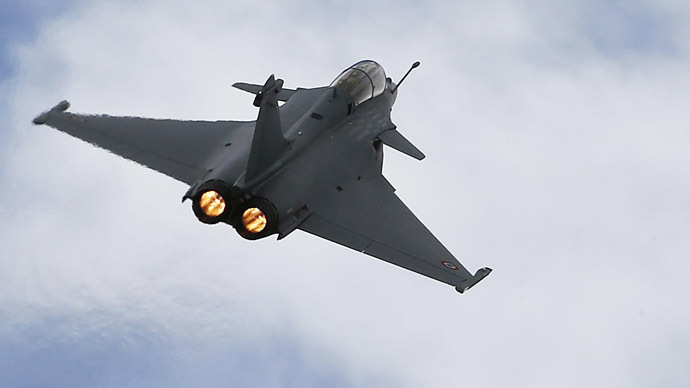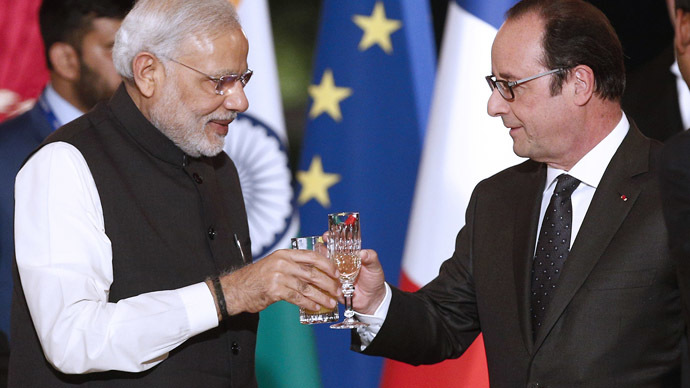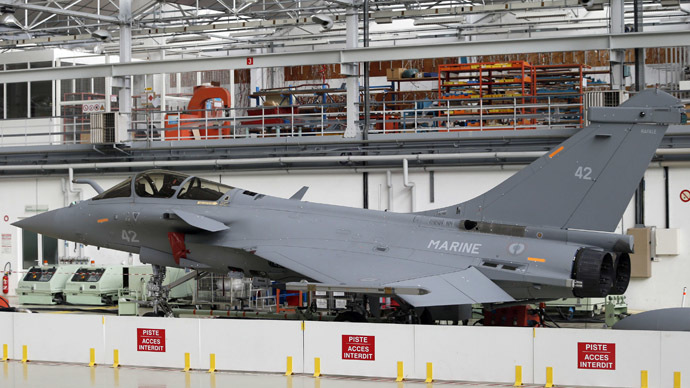Rafale deal: The diplomatic deftness of India’s Modi

India's Rafale deal is not just purchasing fighter jets. It’s also about facing the challenge of national security, and balancing defense relationships as well as bilateral ties. A diplomatic deftness PM Narendra Modi seems to have lived up to.
When India, the world's largest arms importer, makes a defense move it is watched keenly. The recent deal on 36 Rafale jets is no exception.
Speculations are rife on how this deal works for France, and what's in it for India? After all why would New Delhi choose the expensive Rafale which does not command a very impressive list of international customers (other than Egypt), nor does the purchase without a transfer of technology (ToT) in any way compliment India's much touted 'Make in India' campaign of which the defense sector is an integral part.
However, for India more than the question is who the winner is.
Multilevel stroke
Against a required 44 squadrons to be able to effectively
neutralize any external threat the Indian Air Force's (IAF)
assets have come down to just 34. Most of these functioning
squadrons comprised obsolete MiG-21s & MiG-27s ready to be
scrapped in about two years.
Apart from just 55 percent serviceability of new Sukhoi-30MKIs
(200 in service, of 272 ordered for $12 billion), even the
putting into operation the indigenous Teja light combat aircraft
is behind schedule, in addition to the delays in the joint
development of the Russian 5th generation fighter
project.
Prime Minister Modi has been told by his defense team that the earlier MMRCA (medium multi-role combat aircraft) contract - to acquire 126 fighters at a cost to the country $14.43 billion, and a delivery period likely to be over seven years - cannot offer the quick transfusion required for India's air capability. Nor was scrapping the deal and issuing a fresh tender an option as that would have led to expensive penalties.
Instead, reducing the number to 36 jets, expected to be delivered in less than three years, seemed more effective to plug operational gaps. As India based defense analyst Nitin A Gokhale says, “It's neither business nor politics. It is pure operational necessity.”
Then there was also the quotient of global relations. India has been trying to diversify the sources of its arms imports. Although the US and Russia are its largest sources, India recently has come out into the open about its intent to deepen defense ties with countries like Israel, a relationship hitherto kept under wraps for fear of upsetting friends in the Middle East. The reason is, while the US has been a weapons supplier to rivals like Pakistan for a long time, Russia too has recently forged defense ties with Islamabad – much to the discomfort of New Delhi. So deeper French ties seemed fitting as part of India's tryst to spread out its dependence for arms to multiple sources.

This worked well for the French because in lieu of an earlier deadlocked deal they bagged an outright sale of 36 jets without having to part with the technology of these products.
By making this announcement in France Modi has shown the deftness of his diplomatic judgment. His visit saw inking of 17 other crucial agreements, with a nuclear deal being one of them, apart from announcements of French investment in India. This means India is looking at building a broad based balanced relationship where each has considerable stake in the other and not just narrowly dependent on arms trade where India could be severely arm twisted for its vulnerability.
Consider this, as per reports France might divert its own military's production order for Rafale fighter jets to meet India's requirement for 36 warplanes clearly showing France's business compulsions.
Additionally New Delhi has shared a fairly stable relationship with Paris, especially following the 1998 nuclear test by India when France was the first and only Western power to have built strategic partnership with the country.
But back home the deal sparked some strong criticisms for Modi who many thought not only sacrificed the case of “Make in India”, but also drained huge resources with this expensive buy of a jet that many have rejected in the past, including Brazil.
As per this account Brazil not only objected to an additional charge for ToT but also found the quality of the AESA (active electronically scanned array) of Rafale dubious. As a result, the country chose the Swedish Gripen NG fighter.
Concerns have also been sounded about the hidden overheads of Rafale maintenance, and the fact that the IAF inventory already with too many aircraft types would be made more complex by adding another making maintenance more difficult and expensive.
However the Indian defense community looks at it differently. To them the deal’s government to government approach meant circumventing the long drawn out defense acquisition process and accelerating future acquisitions. It also injected a temporary patch, while buying time for India to explore more options for future purchases which could be from the same vendor or another.
As former Air Marshal M Matheswaran and a member in executive council of Institute of Defence Studies and Analysis (IDSA), says, “This is a govt. to govt. deal and a limited business deal. Rafale was declared as L1 (lowest bidder) in the competitive selection process more than three years ago. However, the negotiations have been stuck for too long. In order to break the deadlock the government had to by-pass the RFP (request for proposal or global tender) process. The huge costs involved for 126 aircraft and the urgent requirement of a minimum number to meet immediate requirements of the air force were the considerations.”
Also because this deal did not involve any ToT, the costs were well within limits which actually make a good amount of resources available to the defense ministry. Pegged at some $4.25 billion Dev Mehta, analyst at the Strategic Defense Intelligence (SDI), says the deal for 36 Rafale aircraft actually frees up funds that can partly be used for scaling up production of the Tejas Light Combat Aircraft and the faster induction of the Fifth Generation Fighter Aircraft (FGFA) in collaboration with Russia.
Additionally the French make seems to have an excellent reputation in Indian defense circles. As senior researcher at IDSA, Rajiv Narayan, “It (Rafale) is a preferred weapon of (Indian) air force.”

For instance Matheswaran dismisses the Brazilian case as a non-issue for India as he says, “the level of AESA radar development and maturity is just about the same all over except in USA. The reason why Brazilians chose NG Gripen was more due to cost advantage and more importantly, the technology transfer that Saab was offering.”
Military experts like Vijainder K Thakur, a former IAF Jaguar pilot say these jets come with additional features that protect the aircraft against airborne and ground threats. During operations over Libya, French Rafales reportedly operated independently of Suppression of Enemy Air Defenses (SEAD) platforms.
Allaying the concern of complicating the inventory experts say there is a conscious effort towards type reduction because Rafale replaces two existing types - older variant MiG-21s and MiG-27s.
However, Matheswaran agrees over the long run that maintenance costs would be high due to dependence on the OEMs. But he says, “This could be resolved at a later date.”
More shares for grab
While the deal is done, the suave defense businesses still seem to be hopeful in making a dent in the IAF requirement after the Indian Defense Minister ManoharParrikar's announcement that while the LCA Tejas is a replacement for MiG-21, there are possibilities of building another single engine fighter under 'Make in India' which could also be a replacement for the MiG-21.
Business Insider reports Sweden's Saab and US Lockheed Martin are set to re-pitch their Gripen and F-16 planes, eliminated in the Rafale tender, as the kind of lighter, single-engine aircraft that Mr. Manohar Parrikar talked about.
Saab reportedly was even proposing to establish "fully-fledged production" of the Gripen in India alongside a local partner. On the other hand, Lockheed Martin may also tout its F-16, one of the most widely used fighter planes in the world, as a replacement for Russian-made MiGs that are a mainstay in India's fleet
However, Mehta predicts opportunities for the Su-30MKI (advanced version) are here to stay as the original MMRCA deal falls apart. MiG-35 is a 4 ++ generation aircraft, with a combat capability against air, land and maritime targets, the newer version of the aircraft is now able to carry a heavier load of 6 tonnes as compared to the earlier 4 tonnes.
Nonetheless, future military deals will have to accommodate the 'Make in India' aspect as there will be immense public pressure on the Indian government. The defense circle is already suggesting steps like Maintenance Transfer of Technology (MTOT) for the existing 36 Rafale fighters should go to Indian private vendors.
Reports are already out on the likelihood of the 30 percent offset clause remaining, even in the current deal by which a foreign company has to invest a portion of the deal back into India.
As Wilson Center's South Asia expert Michael Kugelman says, while “36 fighter jets is a pretty nice consolation prize” for Rafale, India wants to strike a balance between defense acquisitions abroad and defense production at home. So in the long run it will want to reduce its dependence on defense exports even though it currently lacks the capacity.
The statements, views and opinions expressed in this column are solely those of the author and do not necessarily represent those of RT.
The statements, views and opinions expressed in this column are solely those of the author and do not necessarily represent those of RT.













